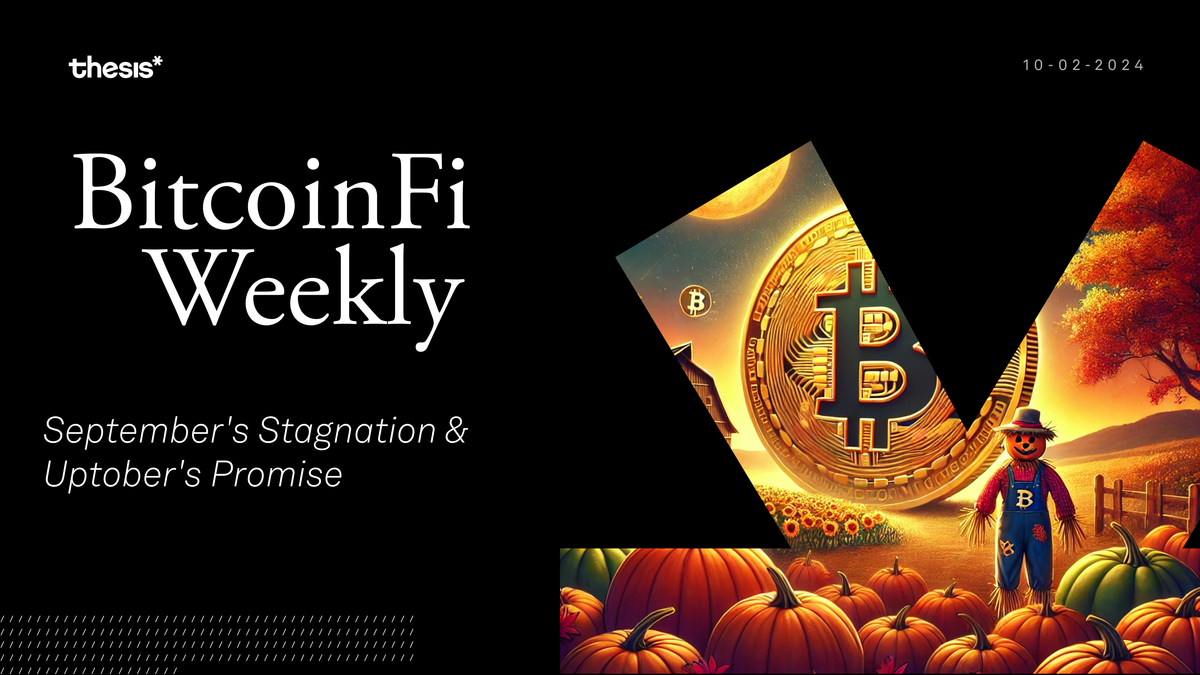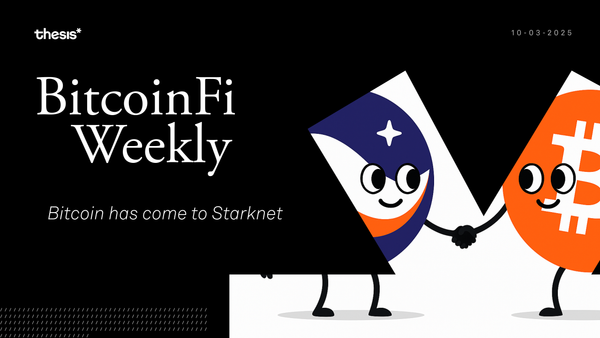September's Stagnation & Uptober's Promise
September, with its hesitations and pauses, was not a lull but a prelude—a setting of the stage for what’s to come. Whales quietly accumulated, innovations like Strata and BitSNARK emerged, and legal battles reshaped the landscape.

Welcome to BitcoinFi Weekly. We cover where people use their BTC and what is changing in the Bitcoin world.
In the suffocating grip of September's waning days, when the very air seems thick with the dying gasps of summer's fevered chop, one cannot help but feel a creeping dread, a nameless anxiety that gnaws at the soul of every wretched trader and Bitcoin miner alike. Yet, as surely as night follows day, so too does October loom on the horizon, bringing with it the promise of renewal, of redemption—dare I say, of profit? But before we let ourselves be swept away by the winds of optimism, we must look back at September—a month of still waters, of waiting, of quiet accumulation beneath the surface.
In this week’s feature, we explore September's muted signals and what they might reveal about the path ahead. We also glimpse into the unfolding stories that will shape Bitcoin in the weeks to come.
Let’s dive in.
Here’s this week’s rundown:
🎃 Feature Piece: September Recapped & Uptober is Nigh
💔 Bitcoin Restaking Platform Hacked
🦢 Swan Bitcoin Billion Dollar Lawsuit
🔓 BitcoinOS Open sources BitSNARK
🚀 The First Ark Transaction
🌏 Unisat owns the East
🤓 Alpen introduces Strata—a Bitcoin ZK-Rollup
Feature Piece: September Recapped & Uptober is Nigh
September always seems to sit in limbo, caught between the choppiness of summer and the market’s anticipation of fourth-quarter gains. For Bitcoin, this year’s September was no exception. It was a month marked by stagnation, with a certain hesitancy to push forward. However, the undercurrents of major events suggest we could be on the cusp of something much bigger. Uptober is on the horizon.
But before we can start peering into the future, let’s recap September. The most glaring observation is the conspicuous absence of the small-time gambler – the retail trader. OKX and Binance, historically the playgrounds of retail traders, are reporting wallet activity levels that pale in comparison to both the heights of the 2021 bull market and the lows of the 2019 bear market. Fewer than 40,000 wallets were active daily in September—less than what we saw when Bitcoin traded below $10,000 during the last bear market. To put that in perspective, even during the dreariest days of 2020, there were still 50,000 active wallets daily.
So, where are the retail traders? Perhaps they're still licking their wounds from previous market cycles, or maybe they're simply waiting for a more obvious signal to join the fray. Whatever the reason, their absence is palpable, and it's creating a fascinating dynamic in the market.
While the small fish have retreated to safer waters, the whales have been quietly accumulating. Analysts at CryptoQuant suggest we’re in the middle of a bull cycle—old whales are waiting for retail exit liquidity, while new whales are accumulating BTC from old whales. Yet, the cautious behavior of retail investors in September is remarkable, given October’s historical significance. Since 2013, October has only twice ended in the red, with gains reaching as high as 60%. The month’s average return sits at a robust 22%, making it historically the best month for Bitcoin—and the whales know it. The inflow of stablecoins onto centralized exchanges surged in September, reaching record highs. USDT reserves, in particular, have climbed to $22.5 billion, and stablecoin market capitalization is now at $169 billion. These assets serve as dry powder, ready to be deployed into Bitcoin.
Beyond onchain activity, macro winds are pushing the narrative further for Uptober. The Federal Reserve’s policy shift, China’s push for liquidity, and the SEC’s approval of institutional options trading on BlackRock’s spot Bitcoin ETF are all positive developments. As the fourth quarter unfolds, these factors will provide the momentum Bitcoin needs to break out of its September slumber.
On the flip side, September was not kind to Bitcoin miners, and they are feeling the pinch, with profitability continuing to fall. JPMorgan’s recent report showed that daily mining revenue dropped for the third consecutive month in September. Miners earned an average of $42,100 per exahash, a 6% decline from August, as block rewards hit their lowest point in recent memory. The network hashrate, on the other hand, rose by 2%, which has only added to the squeeze. With daily gross profit falling to $16,100 per EH/s, miners are generating 3.9 times the revenue of Ethereum stakers, but it’s still not enough to stave off concerns about profitability. This drop in mining profitability is critical to watch as we move into October. Historically, miners selling their Bitcoin rewards at lower prices could put downward pressure on the market. But the rise in institutional interest and the stablecoin liquidity waiting in the wings could easily offset this pressure, setting the stage for an October rally.
As anticipated, derivative markets are awash with activity. Bitcoin futures open interest reached $9.7 billion at the end of September, a 16% month-over-month increase. Despite a 16.1% decrease in futures trading volume, this uptick suggests that traders are positioning themselves for future price movements rather than reacting to current market conditions. In the options market, open interest totaled $17.5 billion, though volume decreased by 28.1%, indicating a growing anticipation of volatility.
So, what’s the outlook for October? With stablecoins loaded on exchanges, institutions ramping up their activity, and historical data on our side, Bitcoin appears poised for another bullish month. But perhaps the most compelling argument for an impending surge comes from the very absence we noted earlier – the retail traders. Their eventual return to the market, drawn by the siren song of rising prices and FOMO, could very well provide the spark that ignites the powder keg of accumulated Bitcoin and stablecoins.
Uptober might just live up to its reputation.
BitcoinFi Updates
Bitcoin Restaking Platform Hacked
Bedrock DeFi is the eighth-largest liquid staking protocol, with over $240 million in TVL. Bedrock’s uniBTC token was exploited on September 27, resulting in a loss of approximately $2 million. The exploit targeted the minting function of uniBTC, enabling attackers to flood liquidity pools with millions of newly minted tokens, siphoning off assets like wBTC. While unfortunate, this type of attack is not unprecedented. Liquidity pools are particularly vulnerable in these scenarios. Yet, there’s a silver lining: the BTC backing uniBTC remains untouched.
The Bedrock team communicated that no actual Bitcoin or wrapped Bitcoin was stolen. This means that while liquidity providers bore the brunt of the losses, the core reserves remain intact. Bedrock is now moving forward with a comprehensive reimbursement plan and will likely reissue a new token for those impacted by the exploit. This will make uniBTC holders whole, though liquidity providers may not be so lucky. Historically, protocols often prioritize compensating token holders over LPs in similar scenarios.
In response to the exploit, Bedrock has announced plans to integrate Chainlink’s Proof of Reserve (PoR), a system that automates onchain checks to ensure secure collateral backing. This step aims to prevent future exploits by embedding cryptographic guarantees that newly minted tokens are fully backed by reserves.
Swan Bitcoin Billion Dollar Lawsuit
Swan Bitcoin has launched a lawsuit against former executives and consultants, accusing them of orchestrating a plan to "steal" its billion-dollar Bitcoin mining business. The lawsuit, filed in late September, alleges that the team, in concert with major investor Tether, attempted to dismantle Swan’s mining operations through a coordinated coup that unfolded over the summer of 2024.
Swan Mining, a venture Swan launched in 2023, purchased ASIC miners at deep discounts during the bear market. Tether backed the project, but tensions emerged as Swan’s mining leadership allegedly conspired with Tether to transfer the mining operation to a separate entity, 2040 Energy.
The lawsuit names Rapha Zagury, Swan’s Chief Investment Officer, as a key player in the plot. It claims he and others resigned in August 2024, taking proprietary data and IP with them to Proton Management, which now controls 2040 Energy. Proton has countered that Swan never fully owned the mining business, as it was always part of 2040 Energy, in which Swan held only a minority stake.
The case hinges on whether Swan’s claim to the mining operation holds up, or if Proton’s assertion that it merely enhanced Swan’s minority stake prevails. Swan faces an uphill fight as it seeks to regain control of its venture, while Proton and Tether push forward with 2040 Energy.
BitcoinOS Open sources BitSNARK
After successfully verifying the first zk-proof on Bitcoin, BitcoinOS has open-sourced their BitSNARK protocol. With BitSNARK, Bitcoin can now host proofs without compromising its core values.BitSNARK operates through a Prover and Verifier mechanism. The Prover submits a zk-SNARK and a BTC stake to deter dishonesty. If the Verifier suspects foul play, they can issue a challenge, risking their own costs in fees and payments to the Prover. This economic incentive structure ensures honesty on both sides, creating a self-enforcing system that secures Bitcoin without overwhelming it with computation.
Looking ahead, BitcoinOS is developing two key innovations: the Grail Bridge, which will enable trustless cross-chain transfers using zk-SNARKs, and the Merkle Mesh, designed for large-scale verification of zk-SNARK proofs.
The First Ark Transaction
A little over a year ago, Ark emerged as a proposed off-chain solution for onboarding users to the Lightning Network. Ark is designed to simplify Bitcoin payments using a client-server model, offering fast, low-cost transactions without compromising user control. It doesn’t aim to replace Lightning but to extend it. Ark users can pay Lightning invoices and eventually receive payments, providing a smoother experience for both developers and users. It strips away Lightning’s complexity while maintaining full compatibility with it. Since then, Ark has quietly evolved into a standalone Bitcoin scaling protocol. With Ark ready for real-world use, the team behind it has formed Second, a company dedicated to pushing Bitcoin’s second-layer scaling technologies forward.
On September 20, 2024, Second demonstrated the first-ever Ark transactions on the Bitcoin mainnet. The demo showcased a command-line tool called Bark. Using Bark, they created wallets and made in-round payments, where multiple transactions were bundled into one on-chain transaction to reduce fees. Out-of-round payments, or "arkoor," were even faster, requiring just one interaction between client and server.
Ark’s integration with Lightning makes it more of an extension than a competitor, so it will be interesting to see how real-world users adapt to and accept Ark’s products.
Unisat Owns the East
Token 2049 showed us that Bitcoin is back and better than ever in the Asian markets. While the West debates Bitcoin maximalism and ideology, Asia markets, led by companies like Unisat, are capitalizing on Bitcoin’s evolving landscape, focusing on profit and scalability. In contrast to the West’s ideological battles over Bitcoin purity, Asian companies are driven by a straightforward focus on profit. This pragmatic approach is reshaping the Bitcoin landscape. Companies like Unisat, Merlin Chain, and BitLayer are launching products with significant trade-offs, but their go-to-market strategies dwarf Western equivalents.
Unisat’s grip on the Asian Bitcoin ecosystem is particularly evident in the rise of Ordinals and the BRC-20 standard. Unisat captured most of the economic benefit of BRC-20s, generating tens of millions in inscription fees. However, despite its dominance, Unisat has largely stayed silent in Western conversations, focusing on the business of ordinals without engaging in technical debates. The SATS BRC-20 token, widely misunderstood by Westerners as a reference to Satoshi Nakamoto or Bitcoin’s subunit, is actually perceived in Asia as a proxy for Unisat itself. In Asia, a bet on SATS is essentially a bet on Unisat’s future.
Unisat’s rise in the East demonstrates how Asia is driving Bitcoin’s second season.
Alpen introduces Strata—a Bitcoin Zk Rollup
This week, Alpen Labs unveiled Strata, a programmable layer built on top of Bitcoin, leveraging ZK proofs to enable trust-minimized applications for Bitcoin.
Strata will initially function as a ZK rollup with an EVM execution environment. This allows existing developers from the Ethereum ecosystem to build on Bitcoin using familiar tools, while Bitcoin provides the ultimate layer of security. Strata also uses Bitcoin for consensus and data availability, meaning that Strata blocks are confirmed by being anchored to the Bitcoin blockchain. One of Strata’s most powerful features is its ability to introduce programmable BTC. Developers can create custom locking conditions for Bitcoin, such as delayed transfers (vaults), transaction limits, privacy-enhanced transactions verified with ZK proofs, and economically secured zero-confirmation payments.
For BitcoinFi, Strata opens the door to a future where Bitcoin is more than just a store of value. It enables smart contracts, programmable BTC, and scalable applications—all with the security of Bitcoin.
Closing Thoughts
As we close this chapter of BitcoinFi Weekly, the quiet resolve of September lingers, a month where the surface remained calm, yet beneath, unseen forces stirred. Now, we stand at the threshold of Uptober, a time that has often rewarded patience with momentum, where history whispers promises of revival and growth.
September, with its hesitations and pauses, was not a lull but a prelude—a setting of the stage for what’s to come. Whales quietly accumulated, innovations like Strata and BitSNARK emerged, and legal battles reshaped the landscape. The caution that marked the month was not without purpose; it was the breath before the plunge, the pause before the next surge.
As we enter October, the promise of what’s to come feels weighty. New protocols will be unveiled, markets will wake from their slumber, and Bitcoin scalability will be tested. See you on the other side.
Thank you for tuning in to this week’s BitcoinFi Weekly. See you next week.
If there's a topic you’d like us to cover or have questions, reach out at [email protected].
Learn more about Mezo at the following channels:
👾 Discord: https://discord.mezo.org
🕊 X: https://twitter.com/MezoNetwork
🖥 Website: https://mezo.org
🏦 Deposit Portal: https://mezo.org/hodl
ℹ️ Docs: https://info.mezo.org





